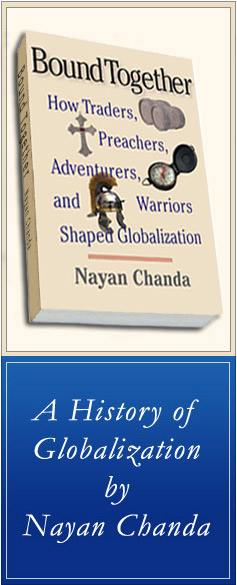
Chapter 1: The African Beginning
This traces the initial globalization of the human species, when in the late Ice Age, a tiny group of our ancestors walked out of Africa in search of better food and security. In fifty thousand years of wandering along ocean coasts and chasing game across Central Asia, they finally settled on all the continents. Along the way, they changed their pigmentation and facial features, and developed different languages and cultures as well. The period of divergence came to a close with the end of the Ice Age. Traders, preachers, soldiers, and adventurers from the emerging urban civilizations of the Levant, India, and China began connecting with one another, launching the process of globalization.
Chapter 2: From Camel Commerce to E-Commerce
This traces the growth of trade from the dawn of human civilization to the present, showing how it has connected an increasingly wider part of the world through a web of commerce. Along with growing trade and expanding merchandise, the means of transportation-from camel caravans to sails powered by the monsoon winds, and from steamboats to container ships and Internet shopping-has continually speeded up...
Chapter 3: The World Inside
Takes a closer look at three everyday products that emerged from global trade and contain within them the story of global interconnectedness. Cotton, originally grown in India, spread to theworld before being supplanted by American cotton. Coffee, known only to the Arab world at one stage, has conquered the globe, providing employment to millions of people whose ancestors never saw a coffee bean...
Chapter 4: Preachers' World
Explores the role that religious preachers played in reaching out and connecting with different human communities. The result of their proselytizing zeal is the domination of the world by three major religions...
Chapter 5: World in Motion
Tells the story of adventurers whose curiosity to discover what lay behind the next mountain or the next island has been a key factor in connecting a geographically separated world. From the Carthaginian commander Hanno, who sailed down Africa's west coast in 500 BCE to the fourteenth- century Moroccan traveler Ibn Battuta, and from Marco Polo to Ferdinand Magellan, countless adventurers have widened the horizon and helped to create the integrated world of today...
Chapter 6: The Imperial Weave
Traces the role of ambitious rulers, the warriors whose universalist aspirations and search for power and glory have taken them to distant lands. From Alexander the Great to Genghis Khan, ambitious men have brought lands and populations under their control...
Chapter 7: Slaves, Germs, and Trojan Horses
Explores the dark underbelly of expanding global connections. As more and more traders, preachers, soldiers, and adventurers have spread out across the world, they have also brought serious problems in their wake. Right from the beginning, they turned war prisoners and captured humans from other lands into slaves. The European discovery of the New World took slavery to a new height in the process, creating multiracial societies in many parts of the Americas. From the plague pathogen carried by traders on the silk route and the smallpox and flu viruses borne by the conquistadors to the SARS virus flying around the world with tourists, global connection has brought its share of disasters...
Chapter 8: Globalization: From Buzzword to Curse
Examines how, with the growing awareness about the interconnected world, from its timid entry into the English vocabulary in 1961, the word globalization has grown into a buzzword. A survey of electronic databases since the 1970s shows that the use of the word grew rapidly in the1990s, when deregulation and technological advances drove worldwide trading and investment...
Chapter 9: Who's Afraid of Globalization?
Explores how, despite the economic growth and prosperity brought about by faster economic integration, globalization has emerged as a toxic word for some people. Protesters from Seattle to Cancun and Genoa to Hong Kong have dogged meetings of the World Trade Organization (WTO) and Group of Eight (G8) nations, com- plaining about undemocratic institutions and unfair policies...
Chapter 10: The Road Ahead
Offers a summary of the process of globalization and looks at its troubled future. Globalization has created an integrated world in which many have been lifted from poverty, but the speeding pace of globalization has left nearly a third of the world's population by the wayside. The global challenge ahead will be somehow to bring into the fold the excluded populations and encourage large developing nations such as China and India to carry on with their open-door policies while stanching the rising nationalist and protectionist tide in the developed West...
